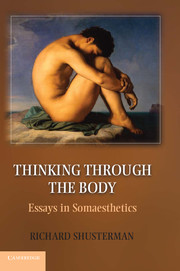Introduction
Published online by Cambridge University Press: 05 November 2012
Summary
I
Initially conceived as a branch of aesthetics within the larger discipline of philosophy, somaesthetics reflects my pragmatist efforts to reshape both these fields. But it has blossomed into a truly interdisciplinary enterprise. Many fine scholars in diverse disciplines have developed the somaesthetic project in fascinating and useful ways. Before introducing the essays that constitute this collection, I should note some of these developments along with the major criticisms somaesthetics has received and the challenges it needs to address in future work. First, however, I should briefly sketch how somaesthetics seeks to reorient its original disciplinary domain of aesthetics and philosophy. The ensuing chapters of this book flesh out this sketch in much greater detail.
Art enchants us through its richly sensuous dimensions, perceived through the bodily senses and enjoyed through embodied feelings. Yet philosophical aesthetics largely neglects the body's role in aesthetic appreciation. No theorist could ignore the frequent focus of painting and sculpture on beautiful bodily forms, nor deny the obvious fact that artworks are made through bodily efforts and skill; but philosophers generally disregard the body's broader aesthetic importance, conceiving it as a mere physical object for artistic representation or a mere instrument for artistic production. Even when Alexander Baumgarten, in the mid-eighteenth century, first defined modern aesthetics explicitly as a science of sensory perception (deriving its name from the Greek word for such perception, αισθησις), the body played no part in his theory, despite the bodily nature of our senses. Although Kant continued to treat aesthetic appreciation in the sensory terms of “judgment of taste” and “feeling of pleasure,” the body remained excluded from its determining “a priori grounds” of form. Truly aesthetic judgments of taste are distinguished from bodily “judgments of sense” in that they involve “not what gratifies in sensation but merely by what pleases by its form,” and are thus untainted with the “merely empirical delight” from somatic feelings, charm, and emotion.
Information
- Type
- Chapter
- Information
- Thinking through the BodyEssays in Somaesthetics, pp. 1 - 23Publisher: Cambridge University PressPrint publication year: 2012
